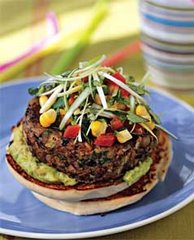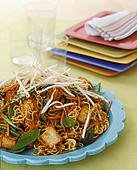My seven year old is a vegetarian. When she started her quest of avoiding meat we thought just cutting out meat itself would be enough, but it has become a journey of shocking, jaw-dropping discovery at just what contains ground-up animal parts. As a result, I am now a veggie. So I have gone from researching good recipes and nutritional information, which is essential for such a young vegetarian, to the family taking on a healthier, more compassionate outlook on life.
Wednesday, 4 April 2007
Jelly - belly?
Gelatine (also gelatin - US spelling) is something we will all have heard of. I know it goes in jelly and some sweets, but again, I was feeling just a little bit nauseous when I realised exactly where it came from.
Gelatin (also known as E number E441) is a translucent, brittle, solid substance, colourless or slightly yellow, nearly tasteless and odourless. It has been commonly used in food, pharmaceutical, photography, and cosmetic manufacturing.
According to Wikipedia: “the worldwide production amount of gelatine is about 300,000 tons per year (roughly 600 million lbs). On a commercial scale, gelatine is made from by-products of the meat and leather industry, mainly pork skins, pork and cattle bones, or split cattle hides.
Recently, by-products of the fishery industry began to be considered as raw material for gelatine production because they eliminate most of the religious obstacles surrounding gelatine consumption.”
Apparently, and contrary to popular belief, horns and hooves are not commonly used. Well, that is good to know.
Edible gelatines
Household gelatine, which can be in the form of sheets, granules or as powder, can be added to the food as they are; others need to be soaked in water beforehand.
Special kinds of gelatine are made only from certain animals or from fish (known as k-gelatine) in order to comply with Jewish kosher or Muslim halal laws.
Fortunately , vegetarians and vegans may substitute similar gelling agents such as agar, nature gum, carrageenan, pectin, or konnyaku, sometimes referred to as "vegetable gelatines" although there is no chemical relationship; they are carbohydrates, not proteins.
The name "gelatine" is colloquially applied to all types of gels and jellies; but properly used, it currently refers solely to the animal protein product. There is no vegetable source for gelatine.
Uses
Probably best known as a gelling agent in cooking, different types and grades of gelatine are used in a wide range of food and non-food products:
Common examples of foods that contain gelatine are gelatine desserts or jelly, trifles, aspic, marshmalloes, and confectioneries such as jelly babies and gummy bears. Gelatine may be used as a stabilizer, thickener, or texturizer in foods such as ice cream, jams, yogurt, cream cheese, margarine; it is used, as well, in fat-reduced foods to simulate the ‘mouth feel of fat’ and to create volume without adding calories.
Gelatine is used for the clarification of juices, such as apple juice, and of vinegar. Isinglass, from the swim bladders of fish, is still in use as a fining agent for wine and beer. Beside hartshorn jelly, from deer antlers, isinglass was one of the oldest sources of gelatine.
Source: International Vegetarian Union
As with all things, it does appear that labelling is key and so keep an eye out for the ‘V,’ although shopping will take hours as you get used to what products are suitable!
However, if there are any products you are not sure about, check out the Vegetarian Society website, http://www.vegsoc.org/seedling.html, they have a list of approved products and you can be sure everything meets their strict criteria.
Gelatin (also known as E number E441) is a translucent, brittle, solid substance, colourless or slightly yellow, nearly tasteless and odourless. It has been commonly used in food, pharmaceutical, photography, and cosmetic manufacturing.
According to Wikipedia: “the worldwide production amount of gelatine is about 300,000 tons per year (roughly 600 million lbs). On a commercial scale, gelatine is made from by-products of the meat and leather industry, mainly pork skins, pork and cattle bones, or split cattle hides.
Recently, by-products of the fishery industry began to be considered as raw material for gelatine production because they eliminate most of the religious obstacles surrounding gelatine consumption.”
Apparently, and contrary to popular belief, horns and hooves are not commonly used. Well, that is good to know.
Edible gelatines
Household gelatine, which can be in the form of sheets, granules or as powder, can be added to the food as they are; others need to be soaked in water beforehand.
Special kinds of gelatine are made only from certain animals or from fish (known as k-gelatine) in order to comply with Jewish kosher or Muslim halal laws.
Fortunately , vegetarians and vegans may substitute similar gelling agents such as agar, nature gum, carrageenan, pectin, or konnyaku, sometimes referred to as "vegetable gelatines" although there is no chemical relationship; they are carbohydrates, not proteins.
The name "gelatine" is colloquially applied to all types of gels and jellies; but properly used, it currently refers solely to the animal protein product. There is no vegetable source for gelatine.
Uses
Probably best known as a gelling agent in cooking, different types and grades of gelatine are used in a wide range of food and non-food products:
Common examples of foods that contain gelatine are gelatine desserts or jelly, trifles, aspic, marshmalloes, and confectioneries such as jelly babies and gummy bears. Gelatine may be used as a stabilizer, thickener, or texturizer in foods such as ice cream, jams, yogurt, cream cheese, margarine; it is used, as well, in fat-reduced foods to simulate the ‘mouth feel of fat’ and to create volume without adding calories.
Gelatine is used for the clarification of juices, such as apple juice, and of vinegar. Isinglass, from the swim bladders of fish, is still in use as a fining agent for wine and beer. Beside hartshorn jelly, from deer antlers, isinglass was one of the oldest sources of gelatine.
Source: International Vegetarian Union
As with all things, it does appear that labelling is key and so keep an eye out for the ‘V,’ although shopping will take hours as you get used to what products are suitable!
However, if there are any products you are not sure about, check out the Vegetarian Society website, http://www.vegsoc.org/seedling.html, they have a list of approved products and you can be sure everything meets their strict criteria.
Subscribe to:
Post Comments (Atom)
































No comments:
Post a Comment